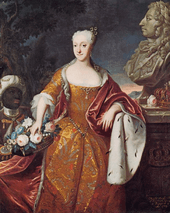Princess Charlotte Amalie of Denmark
| Charlotte Amalie | |
|---|---|
| Princess of Denmark | |
|
Portrait by Peter Wichmann | |
| House | House of Oldenburg |
| Father | Frederick IV of Denmark |
| Mother | Louise of Mecklenburg-Güstrow |
| Born |
6 October 1706 Copenhagen Castle |
| Died |
28 October 1782 (aged 76) Copenhagen |
| Burial | Roskilde Cathedral |
| Religion | Lutheran |
Charlotte Amalie of Danmark (6 October 1706 – 28 October 1782) was a Danish princess, daughter of King Frederick IV of Denmark and Louise of Mecklenburg-Güstrow.
Life

Charlotte Amalie never married. In 1725, she was placed on the list of 99 princesses regarded as suitable for marriage with Louis XV of France (which would require that she convert to Catholicism), but she was removed from the list because Denmark was an arch enemy toward Sweden, the traditional ally of France. In the early 1730s, her brother the king tried to arrange a marriage between her and Frederick, Prince of Wales, but the negotiations did not succeed, and she remained unmarried.
As was the custom for unmarried princesses, she lived with her mother until her mothers death, and then with her stepmother. In contrast to her brother and sister-in-law, she had a good relationship with her stepmother, Anna Sophie Reventlow, with whom she lived, in accordance with custom, after she had became her stepmother. In 1721, when her mother died and her father remarried to Anna Sophie, Charlotte Amalie tried to prevent the worst hostility toward her stepmother at court. She was separated from Anna Sophie when her brother succeeded to the throne in 1730. After this, she lived at the royal court in winters, and at Charlottenlund Palace in summer with her own court.
Charlotte Amalie was described by her contemporaries as a lovable character with the ability to keep the peace with most: she had a good relationship with her father and stepmother, and still managed to have a good relationship also to her brother, who hated his father and stepmother. She had no influence upon the affairs of state, and lived a a peaceful life at court her entire life.
On 8 April 1771, she was ordered to leave court. She spent the rest of her life with her nephews widow, the queen dowager Juliana Maria. This in fact meant that she continued to spend a lot of her time at court, when the queen dowager attended it: Juliana Maria became de facto regent in 1772. As she preferred black wigs, she had ordered her staff to wear them, and her court became known as "The court of the black wigs". After 1778, she no longer showed herself to the public, as she had became senile.
Charlotte Amalie is known as the benefactress of the writer Charlotte Baden, who was the niece of one of her chief ladies-in-waiting, Anna Sophie von den Osten. Baden was raised at her court, and Charlotte Amalie provided her with an education and an allowance.[1] In her will from 1773, Charlotte Amalie created a foundation, Prinsesse C.A.s stiftelse, to finance the upbringing of poor girls of all classes.
Charlottenlund Palace, where she spent her summers, was built and named after her in 1731–1733.
Charlottenlund and Charlotte Amalie, United States Virgin Islands are named after her.
Ancestry
References
- Dansk biografisk Lexikon / III. Bind. Brandt - Clavus 1889
- Dansk Biografisk Leksikon, 1979-84.
- http://www.ses.dk/en/SlotteOgHaver/Slotte/CharlottenlundSlotOgSlotshave/CharlottenlundSlot.aspx
- Charlottas, Hedvig Elisabeth (1902) [1775–1782]. Bonde, Carl Carlson, ed. Hedvig Elisabeth Charlottas dagbok [The diary of Hedvig Elizabeth Charlotte] (in Swedish). I 1775-1782. Translated by Carl Carlson Bonde. Stockholm: P.A. Norstedt & Söners förlag. p. 130. OCLC 14111333. (search for all versions on WorldCat)
External links
| Wikimedia Commons has media related to Princess Charlotte Amalie of Denmark. |
| ||||||||||||||||||||||||||||||||||||||||||||||||||||||||||||||||||
